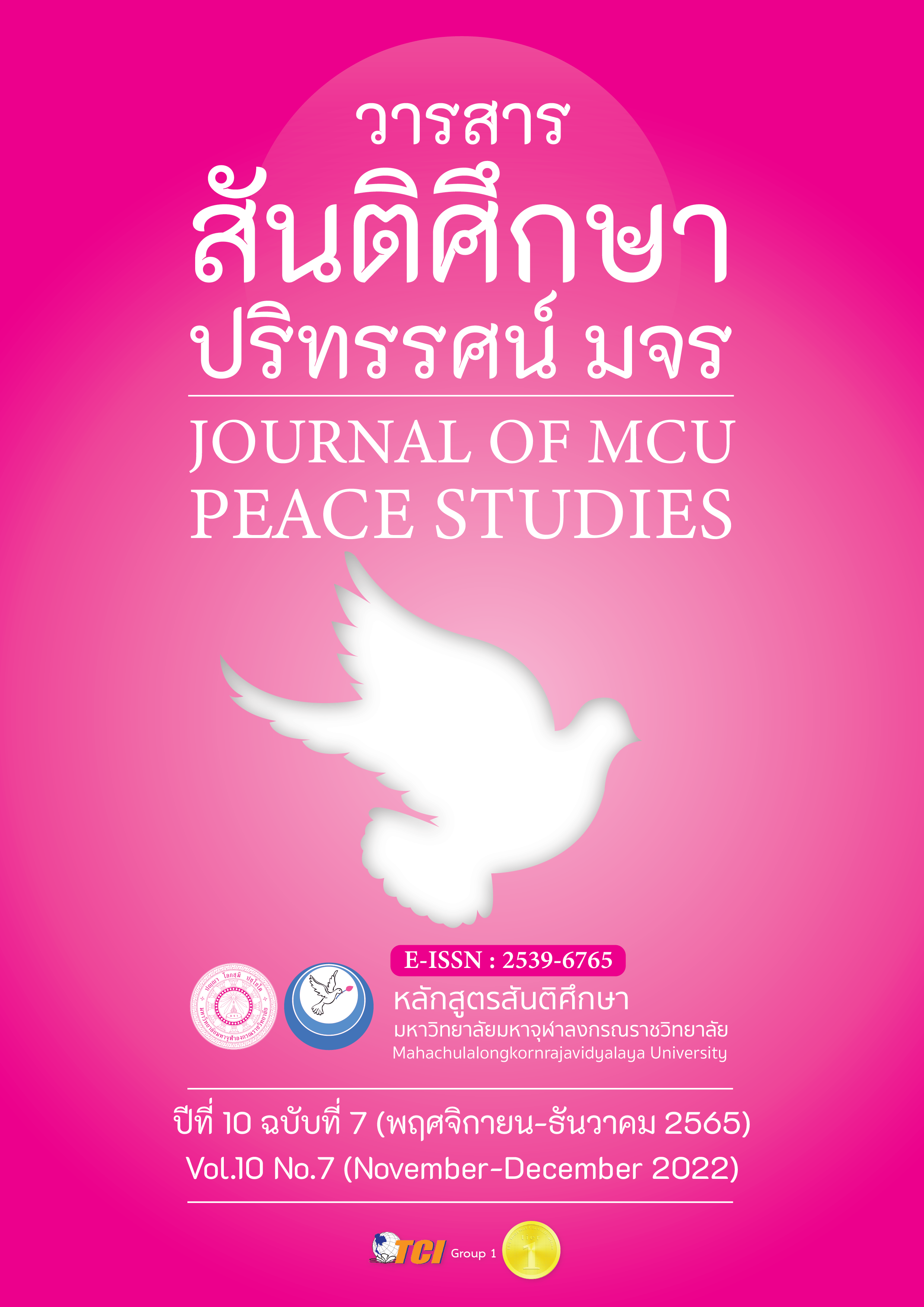การจัดการเรียนรู้แบบใช้ปัญหาเป็นฐานตามแนวคิดสะเต็มศึกษา เพื่อส่งเสริมความสามารถในการแก้ปัญหาอย่างสร้างสรรค์ เรื่อง รูปหลายเหลี่ยม ของนักเรียนชั้นประถมศึกษาปีที่ 6
Main Article Content
บทคัดย่อ
บทความวิจัยนี้มีวัตถุประสงค์เพื่อศึกษา 1) แนวการจัดการเรียนรูแบบใช้ปัญหาเป็นฐานตามแนวคิดสะเต็มศึกษา ที่ส่งเสริมความสามารถในการแกปัญหาอย่างสร้างสรรค์ เรื่อง รูปหลายเหลี่ยม 2) ศึกษาความสามารถในการแกปัญหาอย่างสร้างสรรค์ เรื่อง รูปหลายเหลี่ยม ที่จัดการเรียนรูแบบใช้ปัญหาเป็นฐานตามแนวคิดสะเต็มศึกษา ใช้รูปแบบการวิจัยปฏิบัติการในชั้นเรียน ผู้เข้าร่วมการวิจัย คือ นักเรียนชั้นประถมศึกษาปีที่ 6 จำนวน 24 คนในจังหวัดกำแพงเพชร เครื่องมือที่ใช้ในการวิจัย ได้แก่ แผนการจัดการเรียนรู้ แบบสะท้อนผลการจัดการเรียนรู้ และแบบวัดความสามารถในการแก้ปัญหาอย่างสร้างสรรค์ การวิเคราะห์ข้อมูลใช้การวิเคราะห์เชิงเนื้อหาและสถิติบรรยายค่าเฉลี่ย ร้อยละ
ผลการวิจัยพบว่า
1) แนวการจัดการเรียนรู้แบบใช้ปัญหาเป็นฐานตามแนวคิดสะเต็มศึกษาที่ส่งเสริมความสามารถในการแก้ปัญหาอย่างสร้างสรรค์ ควรใช้ปัญหาที่เชื่อมโยงกับชีวิตประจำวันที่เกี่ยวข้องกับรูปหลายเหลี่ยมที่มีแนวทางการแก้ไขหลายแนวทาง และบูรณาการกับสะเต็มศึกษาได้ ครูจัดเตรียมแหล่งพื้นที่ในชุมชนที่นักเรียนสามารถลงพื้นที่จริงได้ อีกทั้งครูควรกระตุ้นให้นักเรียนประยุกต์ใช้หลักการทางคณิตศาสตร์ในการแก้ปัญหาโดยใช้คำถามปลายเปิด และเปิดโอกาสให้นักเรียนเขียนวิธีแก้ปัญหาของตนและแลกเปลี่ยนวิธีแก้ปัญหากับสมาชิกในกลุ่ม
2) ผลการศึกษาความสามารถในการแก้ปัญหาอย่างสร้างสรรค์ ตามองค์ประกอบทั้ง 4 องค์ประกอบพบว่า นักเรียนส่วนใหญ่มีความสามารถในการทำความเข้าใจปัญหาอยู่ในระดับดีมาก ร้อยละ 45.83 ความสามารถในการสร้างแนวทางหรือวิธีการแก้ปัญหาและการเตรียมความพร้อมเพื่อดำเนินการอยู่ในระดับดี ร้อยละ 50.00 และ 41.67 ตามลำดับ และความสามารถในการการวางแผนการปฏิบัติอยู่ในระดับพอใช้ ร้อยละ 41.67
Article Details

อนุญาตภายใต้เงื่อนไข Creative Commons Attribution-NonCommercial-NoDerivatives 4.0 International License.
ทัศนะและความคิดเห็นที่ปรากฏในบทความในวารสาร ถือเป็นความรับผิดชอบของผู้เขียนบทความนั้น และไม่ถือเป็นทัศนะและความรับผิดชอบของกองบรรณาธิการ ยินยอมว่าบทความเป็นลิขสิทธิ์ของวารสาร
เอกสารอ้างอิง
Chiangkul, W. (2016). The State of Education Report 2014/2015 How Can We Transform Thai Education to Catch up with the World in the 21st Century?. (1st ed.). Bangkok: Pimdee Printing.
Jinwan, W. (2011). Cognitive Load Reduction Web-Based Instruction Model Using Creative Problem Solving Techniques Model upon Cognition and Creativity of Undergraduate Students. Doctor of Philosophy in Technology Technical Education. (Master’s Thesis). King Mongkut’s University of Technology North Bangkok. Bangkok.
Jituafua A. (2020). The Development of Science Student Teacher’s STEM Literacy Through the Community Participation Combined with Local STEM Education Camp in Surat Thani. Journal of Education Naresuan University, 22(2), 302-315.
Katwibun, D. (2018). Problem-Based Learning for Mathematics Teacher. (1st ed.). Chiang Mai: Jarusprint.
Kemmis, S., & McTaggart, R. (2000). Participatory Action Research In N. Denzin & Y. Lincoln (Eds.), Handbook of Qualitative Research. (2nd ed.). Thousand Oaks, CA: Sage.
Khongyam, K. (2017). Instruction Package Using Open-Ended Questions for Encouraging Creative Thinking in Mathematics of Secondary Education Students at Khlungratchadapisak School. (Master’s Thesis). Burapha University. Chon Buri.
Lou, S. J., Shih, R. C., Diez, C. R., & Tseng, K. H. (2011). The Impact of Problem-Based Learning Strategies on STEM Knowledge Integration and Attitudes: An Exploratory Study Among Female Taiwanese Senior High School Student. International Journal of Technology and Design Education, 10798(21), 199.
Ministry of Education, Department of Curriculum, and Instruction Development. (2008). Basic Education Core Curriculum B.E. 2551 (A.D.2008). (1st ed.). Bangkok: The Agricultural Cooperative Federation of Thailand. Limited.
National Institute of Educational Testing Service (Public Organization). (2019). Test Report Educational at the National Basic Level. Retrieved July 10, 2020, from http://www.new onetresult.niets.or.th/AnnouncementWeb/School/ReportSchoolBySchool.aspx?mi=2/ SbjStatbySchool_2562_P6_1062020079%20.pdf
Phoonsawat, N. (2019). Problem-Based Learning Activity for Developing Students’ Creative Problem Solving Ability and their Learning Achievements on Cells and Cellular Respiration of Secondary Students at the 10th Grade. (Master’s Thesis). Rajabhat Maha Sarakham University. Maha Sarakham.
Smith, Margaret S., & Stein M. (2011). 5 Practices for Orchestrating Productive Mathematics Discussions. Reston. The National Council of Teachers of Mathematics, 111(5), 367-369.
Supap, W. (2018). Mathematics Learning Based on STEM Education: Approach, Expectation, and Challenge. Journal of Education Naresuan University, 20(4), 302-315.
Thammawongsa, B. (2018). Encourage the Child to Think Critically the Teacher Had to Stop Asking If He Understood or Not Hurry to Answer the Answer. Retrieved August 7, 2020, from https://www.aksorn.com/en/think-critically
The Institute for the Promotion of Teaching Science and Technology. (2015). Problem Solving Capacity for the World of Tomorrow. Bangkok: The Institute for the Promotion of Teaching Science and Technology.
Treffinger, D. J., Isaksen, S. G., & Dorval, K. B. (2010). Creative Problem solving (CPS Version 6.1™) a Contemporary Framework for Managing Change. Sarasota, FL: Center for Creative Learning. Retrieved July 25, 2020, from: www.creativelearning.com/images/ freePDFs/CPSVersion61.pdf


